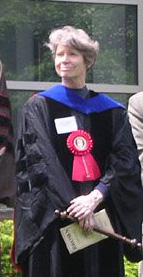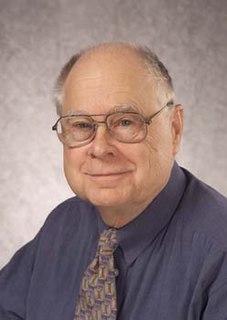Related Research Articles

The American Astronomical Society is an American society of professional astronomers and other interested individuals, headquartered in Washington, DC. The primary objective of the AAS is to promote the advancement of astronomy and closely related branches of science, while the secondary purpose includes enhancing astronomy education and providing a political voice for its members through lobbying and grassroots activities. Its current mission is to enhance and share humanity's scientific understanding of the universe.
The Harold C. Urey Prize is awarded annually by the Division for Planetary Sciences of the American Astronomical Society. The prize recognizes and encourages outstanding achievements in planetary science by a young scientist. The prize is named after Harold C. Urey.

Harold (Hal) Masursky was an American astrogeologist.

Davies is a crater on Mars located at 46°N 0°E on the fringe of Acidalia Planitia near Arabia Terra. It is approximately 48 km in diameter. The crater's name was formally approved by the IAU in 2006.
Bruce William Hapke is a noted American planetary scientist, currently a professor emeritus at the University of Pittsburgh and a specialst in bidirectional reflectance spectroscopy.
The Division for Planetary Sciences (DPS) is a division within the American Astronomical Society (AAS) devoted to solar system research. It was founded in 1968. The first organizing committee members were: Edward Anders, Lewis Branscomb, Joseph W. Chamberlain, Richard M. Goody, John S. Hall, Arvidas Kliore, Michael B. McElroy, Tobias Owen, Gordon Pettengill, Carl Sagan, and Harlan James Smith. As of 2009, it is the largest special-interest division within the AAS. As of Oct 2010, membership totaled approximately 1415 planetary scientists and astronomers, including about 20% residing outside the U.S.
The Carl Sagan Medal for Excellence in Public Communication in Planetary Science is an award established by the Division for Planetary Sciences of the American Astronomical Society to recognize and honor outstanding communication by an active planetary scientist to the general public. It is awarded to scientists whose efforts have significantly contributed to a public understanding of, and enthusiasm for planetary science.
Joseph Burns is a professor at Cornell University with a dual appointment in the Sibley School of Mechanical and Aerospace Engineering (MAE) and the Astronomy department. His primary area of research is dynamics in planetary sciences.
Philip D. Nicholson is an Australian-born professor of astronomy at Cornell University in the Astronomy department specialising in Planetary Sciences. He has been editor-in-chief of the journal Icarus since 1998.

Reta F. Beebe is an American astronomer, author, and popularizer of astronomy. She is an expert on the planets Jupiter and Saturn, and the author of Jupiter: The Giant Planet. She is a professor emeritus in the Astronomy Department at New Mexico State University and 2010 winner of the NASA Exceptional Public Service medal.

Carle McGetchin Pieters is an American planetary scientist. Pieters has published more than 150 research articles in peer-reviewed journals and was co-author of the book Remote Geochemical Analyses: Elemental and Mineralogical Composition along with Peter Englert. Her general research efforts include planetary exploration and evolution of planetary surfaces with an emphasis on remote compositional analyses.

Mark Robert Showalter is a Senior Research Scientist at the SETI Institute. He is the discoverer of six moons and three planetary rings. He is the Principal Investigator of NASA's Planetary Data System Rings Node, a co-investigator on the Cassini–Huygens mission to Saturn, and works closely with the New Horizons mission to Pluto.

William J. (Bill) Borucki is a space scientist who worked at the NASA Ames Research Center. Upon joining NASA in 1962, Borucki designed the heat shields for Apollo program spacecraft. He later turned his attention to the optical efficiency of lightning strikes in the atmospheres of planets, investigating the propensity that these lightning strikes could create molecules that would later become the precursors for life. Subsequently, Borucki's attention turned to extrasolar planets and their detection, particularly through the transit method. In light of this work, Borucki was named the principal investigator for NASA's Kepler mission, launched on March 6, 2009 and dedicated to a transit-based search for habitable planets. In 2013, Borucki was awarded the United States National Academy of Sciences's Henry Draper Medal for his work with Kepler. In 2015 he received the Shaw Prize in Astronomy.
William E. "Bill" Brunk was an American astronomer and NASA administrator.
Sarah T. Stewart-Mukhopadhyay is an American planetary scientist known for studying planet formation, planetary geology, and materials science. She is a professor at the University of California, Davis in the Earth and Planetary Sciences Department. She was a professor at Harvard University Department of Earth and Planetary Sciences from 2003 to 2014.

Athena Coustenis is an astrophysicist specializing in planetology. Dr. Coustenis, a French national, is director of research, Centre national de la recherche scientifique, at LESIA, at the Paris Observatory, Meudon. She is involved in several space mission projects for the European Space Agency (ESA) and for NASA. Her focus is on gas giant planets Saturn, Jupiter and their moons, and she is considered a foremost expert on Saturn's Titan (moon).

Christina "Chrissy" Richey is an American planetary scientist and astrophysicist working at Jet Propulsion Laboratory in La Cañada Flintridge, California. Richey is a Project Staff Scientist for the Europa Clipper mission and is a Research Technologist in the Astrophysics and Space Sciences Section. Prior to working at JPL, Richey worked as contractor for Arctic Slope Regional Corporation at NASA Headquarters in Washington, D.C. They were a Program Officer in NASA's Planetary Science Division, the Deputy Program Scientist for the OSIRIS-REx mission, and the Deputy Science Advisor for Research and Analysis for the Science Mission Directorate.

Faith Vilas is an American planetary scientist and Director of the MMT Observatory in Arizona.
Susan Niebur (1973–2012) was an American planetary scientist, promoter of women in science, and mommyblogger.
References
- ↑ "Harold Masursky Award for Meritorious Service to Planetary Science". American Astronomical Society. Retrieved 21 December 2014.